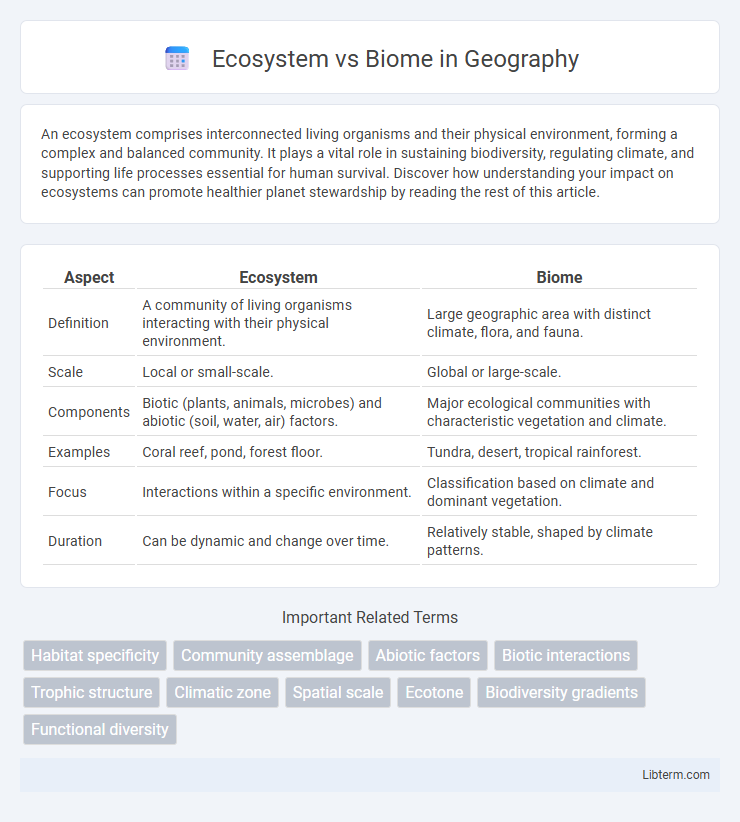An ecosystem comprises interconnected living organisms and their physical environment, forming a complex and balanced community. It plays a vital role in sustaining biodiversity, regulating climate, and supporting life processes essential for human survival. Discover how understanding your impact on ecosystems can promote healthier planet stewardship by reading the rest of this article.
Table of Comparison
| Aspect | Ecosystem | Biome |
|---|---|---|
| Definition | A community of living organisms interacting with their physical environment. | Large geographic area with distinct climate, flora, and fauna. |
| Scale | Local or small-scale. | Global or large-scale. |
| Components | Biotic (plants, animals, microbes) and abiotic (soil, water, air) factors. | Major ecological communities with characteristic vegetation and climate. |
| Examples | Coral reef, pond, forest floor. | Tundra, desert, tropical rainforest. |
| Focus | Interactions within a specific environment. | Classification based on climate and dominant vegetation. |
| Duration | Can be dynamic and change over time. | Relatively stable, shaped by climate patterns. |
Defining Ecosystems and Biomes
Ecosystems are dynamic communities of living organisms interacting with their physical environment, including air, water, and soil, to form a functional unit that supports life processes. Biomes represent large geographic areas characterized by distinct climate conditions, flora, and fauna, such as tropical rainforests, deserts, or tundras. While ecosystems vary in scale and can exist within biomes, biomes provide broad ecological classifications based on climate and dominant vegetation types.
Key Characteristics of Ecosystems
Ecosystems are dynamic complexes of living organisms interacting with their physical environment, defined by energy flow and nutrient cycling within a specific area. Key characteristics include biodiversity levels, trophic structures, climate influence, and the presence of producers, consumers, and decomposers that maintain ecological balance. Unlike biomes, which categorize large regions by climate and vegetation, ecosystems emphasize localized biotic and abiotic interactions and ecological processes.
Fundamental Traits of Biomes
Biomes are large ecological areas characterized by distinct climate patterns, flora, and fauna adapted to specific environmental conditions, differentiating them from ecosystems which are smaller and more localized. Fundamental traits of biomes include temperature ranges, precipitation levels, soil types, and dominant vegetation that collectively influence biodiversity and ecological processes. Examples such as tropical rainforests, deserts, tundras, and grasslands each exhibit unique adaptations and energy flow dynamics critical for sustaining their biological communities.
Scale and Structure: Ecosystem vs Biome
An ecosystem encompasses all living organisms and their physical environment interacting as a single unit within a specific area, characterized by biodiversity, nutrient cycles, and energy flows. Biomes represent larger geographic regions defined by climate, vegetation, and dominant life forms, such as deserts, tundras, and rainforests, composed of multiple ecosystems sharing similar environmental conditions. The key difference lies in scale: ecosystems are localized and dynamic, while biomes cover expansive territories with broad structural patterns shaped by climate and geography.
Biological Diversity in Ecosystems and Biomes
Ecosystems and biomes both encompass biological diversity, but ecosystems focus on specific interactions among organisms and their environment within a smaller area, leading to a rich variety of species and ecological niches. Biomes represent larger geographic regions characterized by dominant vegetation and climate patterns, supporting diverse but broadly adapted biological communities across continents. Understanding biological diversity at the ecosystem level highlights species interactions and functional roles, while biome-level diversity emphasizes adaptation to environmental gradients and large-scale biodiversity distribution.
Abiotic and Biotic Factors Compared
Ecosystems encompass interactions between biotic components like plants, animals, and microbes, alongside abiotic factors such as soil, water, and climate within a specific environment. Biomes are larger areas characterized primarily by dominant vegetation and climate patterns, which influence the types of abiotic conditions like temperature and precipitation, and the biotic communities adapted to them. The key difference lies in scale and specificity: ecosystems focus on dynamic relationships and energy flow between biotic and abiotic elements, while biomes categorize broad ecological regions defined by similar abiotic climates and dominant biota.
Types of Ecosystems Explained
Ecosystems are categorized into terrestrial, freshwater, and marine types, each hosting distinct communities of organisms and environmental conditions. Terrestrial ecosystems include forests, deserts, grasslands, and tundras, characterized by specific vegetation and climate patterns. Freshwater ecosystems comprise lakes, rivers, and wetlands, supporting diverse aquatic life, while marine ecosystems cover oceans, coral reefs, and estuaries, essential for global biodiversity and climate regulation.
Major Biome Classifications Worldwide
Major biome classifications worldwide include tundra, desert, tropical rainforest, grassland, temperate forest, boreal forest, and freshwater and marine aquatic biomes. Each biome represents large geographic areas characterized by specific climate conditions, vegetation types, and animal communities. Ecosystems exist within these biomes and include interactions between living organisms and their physical environment on varying scales.
Human Impact on Ecosystems and Biomes
Human activities significantly alter ecosystems and biomes by causing habitat destruction, pollution, and climate change, which disrupt biodiversity and ecological balance. Urbanization and deforestation fragment ecosystems, reducing species populations and resilience, while global warming modifies biome distribution by shifting temperature and precipitation patterns. Conservation efforts and sustainable practices are critical to mitigating these impacts and preserving ecosystem functions and biome integrity.
Ecosystem and Biome Conservation Strategies
Ecosystem conservation strategies prioritize maintaining biodiversity, restoring habitats, and ensuring ecological processes such as nutrient cycling and energy flow remain intact to support species survival and resilience. Biome conservation focuses on preserving large-scale climatic and geographic regions, protecting representative species and natural communities while addressing climate change impacts and human encroachment threats. Integrating both approaches enhances environmental stability by balancing local ecosystem health with global biome preservation to sustain Earth's biological diversity.
Ecosystem Infographic

 libterm.com
libterm.com